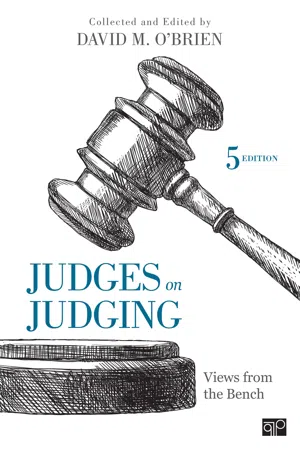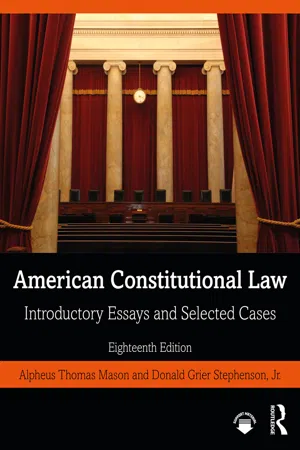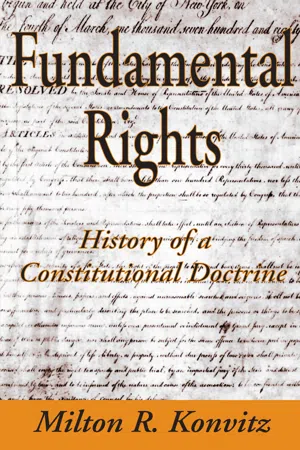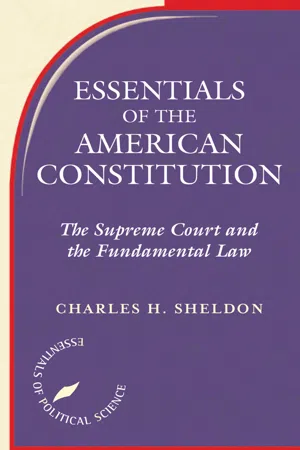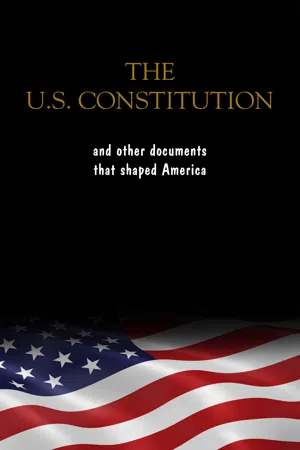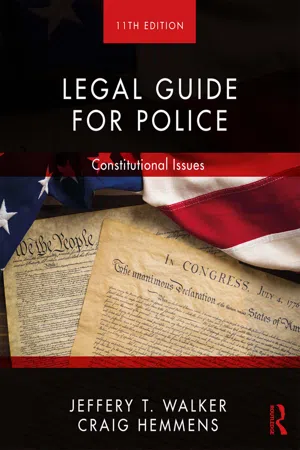Law
US Bill of Rights
The US Bill of Rights is the first ten amendments to the United States Constitution, which outline specific protections for individual liberties and rights. These amendments include guarantees such as freedom of speech, religion, and the press, as well as the right to bear arms, protection against unreasonable searches and seizures, and the right to a fair trial.
Written by Perlego with AI-assistance
6 Key excerpts on "US Bill of Rights"
Learn about this page
Index pages curate the most relevant extracts from our library of academic textbooks. They’ve been created using an in-house natural language model (NLM), each adding context and meaning to key research topics.
- eBook - ePub
Judges on Judging
Views from the Bench
- David M. O′Brien(Author)
- 2016(Publication Date)
- CQ Press(Publisher)
Chapter 30 The Bill of RightsHugo L. BlackJustice, Supreme Court of the United States (1937–1971)What is a Bill of Rights ? In the popular sense it is any document setting forth the liberties of the people. I prefer to think of our Bill of Rights as including all provisions of the original Constitution and Amendments that protect individual liberty by barring government from acting in a particular area or from acting except under certain prescribed procedures. I have in mind such clauses in the body of the Constitution itself as those which safeguard the right of habeas corpus, forbid bills of attainder and ex post facto laws, guarantee trial by jury, and strictly define treason and limit the way it can be tried and punished. I would certainly add to this list the last constitutional prohibition in Article Six that “no religious Test shall ever be required as a Qualification to any Office or public Trust under the United States.”I shall speak to you about the Bill of Rights only as it bears on powers of the Federal Government. Originally, the first ten amendments were not intended to apply to the states but, as the Supreme Court held in 1883 in Barron v. Baltimore,1 were adopted to quiet fears extensively entertained that the powers of the big new national government “might be exercised in a manner dangerous to liberty.” I believe that by virtue of the Fourteenth Amendment, the first ten amendments are now applicable to the states, a view I stated in Adamson v. California.2 I adhere to that view. In this talk, however, I want to discuss only the extent to which the Bill of Rights limits the Federal Government.In applying the Bill of Rights to the Federal Government there is today a sharp difference of views as to how far its provisions should be held to limit the lawmaking power of Congress. How this difference is finally resolved will, in my judgment, have far-reaching consequences upon our liberties. I shall first summarize what those different views are. - eBook - ePub
American Constitutional Law
Introductory Essays and Selected Cases
- Donald Grier Stephenson Jr., Alpheus Thomas Mason(Authors)
- 2021(Publication Date)
- Routledge(Publisher)
9 The Bill of Rights and the Second Amendment DOI: 10.4324/9781003164340-10 The very purpose of a Bill of Rights was to withdraw certain subjects from the vicissitudes of political controversy, to place them beyond the reach of majorities and officials and to establish them as legal principles to be applied by the courts…. [F]undamental rights may not be submitted to vote; they depend on the outcome of no election. —J ustice R obert H. J ackson (1943) Preceding chapters have shown that the Supreme Court’s regard for certain strictures in the Constitution dates from the earliest years of the Republic. Aside from property interests, however, judicial attention to the Bill of Rights, though it has been part of the Constitution since 1791, is of more recent origin. Almost all cases that have shaped the meaning of constitutionally protected expression (the First Amendment) and that have defined personal liberty and the rights of persons accused of crimes (the Fourth, Fifth, Sixth, and Eighth Amendments) have been decided since 1920. As late as the 1935–1936 term, only two of the Court’s 160 decisions concerned a nonproperty-related civil liberty (a guaranty in law against unwarranted governmental intrusion into one’s life) or civil right (a legally protected freedom to participate in society and in the political system on an equal footing with others). In 1960–1961, the number increased to 54 of the 120 cases decided by full opinion. Disproportionate judicial concern for these matters continues. In 2005–2006, cases involving the Bill of Rights and related provisions accounted for 34 of the term’s 87 decisions, and in 2019–2020, 29 of that term’s 53 decisions - eBook - ePub
Fundamental Rights
History of a Constitutional Doctrine
- Milton Konvitz(Author)
- 2017(Publication Date)
- Routledge(Publisher)
3 The Bill of Rights: A Bill of Fundamental RightsI.
We have seen that, despite rebuffs, Justices of the Supreme Court, time and again in strong dissenting opinions, affirmed their belief that fundamental rights are privileges and immunities guaranteed by the Constitution against denial or abridgment by the States. What are these fundamental rights? Perhaps the fullest and broadest enumeration of such rights was formulated by Justice Bradley in Slaughter-House. 1 His dissenting opinion is historically notable, however, for another reason, for we find in it, for the first time, the contention that Section 1 of the Fourteenth Amendment somehow “incorporates” the first eight amendments of the Constitution, that the rights enumerated in the Bill of Rights areamong the privileges and immunities of citizens of the United States, or what is still stronger for the force of the argument, the rights of all persons whether citizens or not.Since Justice Bradley made this contention in 1873, it has had an erratic career in constitutional jurisprudence, and has been disputed and refined, but the essence of Justice Bradley’s idea has won out and has become firmly fixed as constitutional doctrine. We can trace here only the main lines of this highly significant aspect of the idea of fundamental rights.Three years later, in 1876, the Court decided, what was perhaps the first case in which the claim was explicitly made, that one of the provisions of the Bill of Rights formulated a privilege or an immunity which a State may not infringe. In Walker v. Sauvinet, 2 - eBook - ePub
- Stephen L Wasby(Author)
- 2018(Publication Date)
- Routledge(Publisher)
[I]t is part of the history of the day, that the great revolution which established the Constitution of the United States was not effected without immense opposition. Serious fears were extensively entertained that those powers which the patriot statesmen, who then watched over the interests of our country, deemed essential to the union, and to the attainment of those invaluable objects for which the union was sought, might be exercised in a manner dangerous to liberty. In almost every convention by which the Constitution was adopted, amendments to guard against the abuse of power were recommended. … In compliance with the sentiment thus generally expressed, to quiet fears thus extensively entertained, amendments were proposed by the required majority in Congress, and adopted by the states.Similarly, in West Virginia Board of Education v. Barnette (1943), the Court reminded us: “Without promise of a limiting Bill of Rights it is doubtful if our Constitution could have mustered enough strength to enable its ratification.” But what choices has the Bill of Rights given the Supreme Court as it contemplates issues of the rights of individuals versus the rights of society and the role of government in the conflict?Procedural and Substantive Rights
Perhaps the most obvious distinction to be drawn among the various provisions found in the first nine amendments to the Constitution is between substantive and procedural rights. The First Amendment’s provisions of free exercise of religion, free speech, press, assembly, and petition and its prohibition against an established religion, along with the Ninth Amendment’s admonishment that the enumeration of rights does not deny the existence of others and the recently enunciated right of privacy, constitute the substantive rights. In contrast, the Fourth Amendment’s protections against unreasonable search and seizure and double jeopardy, the Fifth Amendment’s due process, speedy public trial, just compensation provisions, and protection against self-incrimination; the Sixth Amendment’s right to counsel; the provision for the right to a jury in a civil trial in the Seventh Amendment; and the Eighth Amendment’s admonishments against excessive bail and fines and cruel and unusual punishment constitute the procedural aspects of the Bill of Rights.Substantive Rights
Western political thought, from the time of the Greeks to the present, has assumed the reasonableness of humans. Although circumstances may be such that passions override reason, humans have the potential to determine their own political fate. It is the purpose of the Bill of Rights to create and maintain the optimum conditions for the exercise of reason. In order to make decisions about our political fate, we must be able to read, write, worship, gather together with others to discuss issues, and, if need be, act upon decisions by petitioning government. Experimenting, contemplating, and reasoning without intervention from government are also encouraged by a high degree of privacy. John Stuart Mill, in his classic book On Liberty - Founding Fathers, James Madison(Authors)
- 2021(Publication Date)
- AA Press(Publisher)
Amendments to the ConstitutionFirst Amendment — Freedom of Religion, Speech, Press, Assembly, and Petition
Passed by Congress September 25, 1789. Ratified December 15, 1791. The first 10 amendments form the Bill of RightsCongress shall make no law respecting an establishment of religion, or prohibiting the free exercise thereof; or abridging the freedom of speech, or of the press; or the right of the people peaceably to assemble, and to petition the Government for a redress of grievances.Second Amendment — Right to Bear Arms
Passed by Congress September 25, 1789. Ratified December 15, 1791. The first 10 amendments form the Bill of Rights A well regulated Militia, being necessary to the security of a free State, the right of the people to keep and bear Arms, shall not be infringed.Third Amendment — Quartering of Soldiers
Passed by Congress September 25, 1789. Ratified December 15, 1791. The first 10 amendments form the Bill of Rights No Soldier shall, in time of peace be quartered in any house, without the consent of the Owner, nor in time of war, but in a manner to be prescribed by law.Fourth Amendment — Search and Seizure
Passed by Congress September 25, 1789. Ratified December 15, 1791. The first 10 amendments form the Bill of RightsThe right of the people to be secure in their persons, houses, papers, and effects, against unreasonable searches and seizures, shall not be violated, and no Warrants shall issue, but upon probable cause, supported by Oath or affirmation, and particularly describing the place to be searched, and the persons or things to be seized.Fifth Amendment — Grand Jury, Double Jeopardy, Self Incrimination, Due Process, Takings
Passed by Congress September 25, 1789. Ratified December 15, 1791. The first 10 amendments form the Bill of Rights- eBook - ePub
Legal Guide for Police
Constitutional Issues
- Jeffery T. Walker, Craig Hemmens(Authors)
- 2019(Publication Date)
- Routledge(Publisher)
AppendixThe Bill of Rights (First Ten Amendments to the Constitution) and the Fourteenth Amendment
The first ten Amendments were ratified December 15, 1791, and form what is commonly referred to as the “Bill of Rights.” The Fourteenth Amendment was ratified July 9, 1868. Originally intended to address state efforts to limit the rights of freed slaves in the post-Civil War South, the Amendment later was interpreted to apply, in large part, the provisions of the Bill of Rights to the states. These amendments are set forth in the following:
